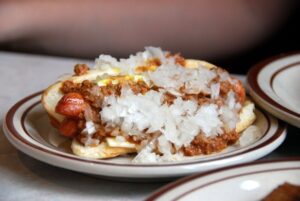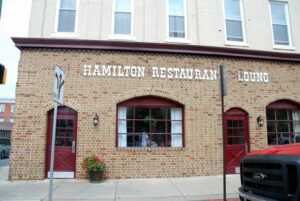Walking into The Hamilton Restaurant is like getting a warm hug from Carlisle’s history—except this hug comes with chili, mustard, and a lot of diced onions. As the self-proclaimed “Home of the Hot-Chee Dog,” The Hamilton has its status far beyond your one-stop place to grab lunch, it’s a local legend with a side of fries.
Our class visit felt like a backstage pass to the soul of Carlisle. We sat down with Thomas Mazias, the 81-year-old owner who took us on a verbal stroll down memory lane. Starting as a dishwasher at 11 years old after fleeing war-torn Greece, Thomas now runs Carlisle’s oldest restaurant with the passion of someone who knows that what they’re serving is tradition and a sense of comfort from the laid-back approach to cooking signature to small-town diner.
The Immigrant Narrative and Resilience

Caraveo, J. (2021, April 8). Photo of Thomas Mazias at The Hamilton Restaurant [Photograph]. Local21 News. https://local21news.com/news/proudly-pennsylvanian/proudly-pa-how-a-carlisle-restaurant-owner-went-from-dishwasher-to-boss
The Hot-Chee Dog as a Cultural Artifact
The enduring popularity of the Hot-Chee Dog demonstrates how food can become a localized symbol of identity. Holtzman, among many food studies scholars have pointed out how food acts as a cultural mediator, embodying community values and shared experiences (Holtzman, 2006). For Carlisle residents, the Hot-Chee Dog is a ritual that links them to the town’s history and each other. Whether it’s lawyers on lunch breaks or college students nursing a case of the late-night munchies, everyone who visits The Hamilton partakes in a collective tradition.

PandaBytes. (2016, January 8). Photo of Hamilton’s Hot-Chee Dog [Photograph]. PandaBytes. https://pandabytes.blogspot.com/2016/01/hamilton-restaurant.html
Reflecting on the Role of Local Restaurants in Food Studies
Visiting Hamilton provided a vivid example of how food studies intersect with themes of identity, community, and migration. The restaurant embodies a deep sense of tradition while grappling with the challenges of remaining relevant in an ever-changing culinary landscape.

Photo courtesy of Helen Van
One of the ways Hamilton has adapted is by working with Warrington Farms, a local butcher, to maintain a short food supply chain (T. Mazias, personal communication, November 26, 2024). This partnership not only ensures the quality of their ingredients but also aligns with the rising emphasis on environmental sustainability in the food system. By sourcing locally, Hamilton reduces its carbon footprint while supporting another small business in the community—a reflection of the interconnectedness of local economies and sustainable practices.
However, the balancing act between nostalgia and innovation is ongoing. On one hand, Hamilton’s charm lies in its old-school simplicity, with its no-frills menu and consistent offerings. On the other hand, adapting to modern consumer habits is essential for survival. For example, the restaurant still operates as cash-only, a relic of a bygone era. But change is on the horizon: Thomas’s nephew is planning to install card payment systems, a nod to the increasing reliance on digital transactions.
References:
Holtzman, J. D. (2006). Food and Memory. Annual Review of Anthropology, 35, 361–378. http://www.jstor.org/stable/25064929
Dickinson College. (n.d.). Where did all the Greeks go? The Hamilton Restaurant: Home of the Hot-Chee Dog. Retrieved November 26, 2024, from https://blogs.dickinson.edu/carlislehistory/where-did-all-the-greeks-go-the-hamilton-restaurant-home-of-the-hot-chee-dog/